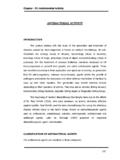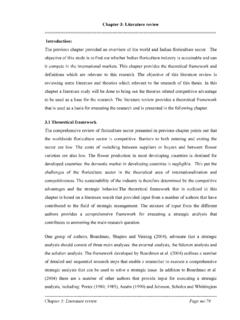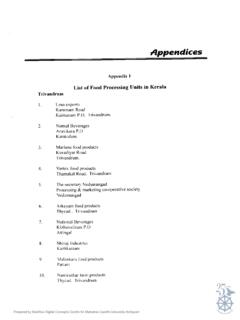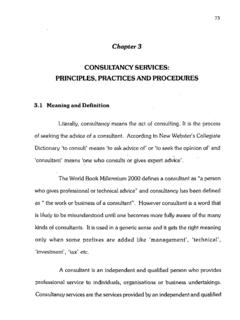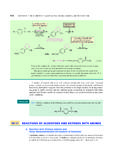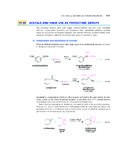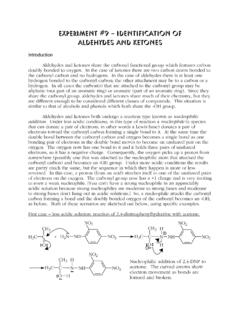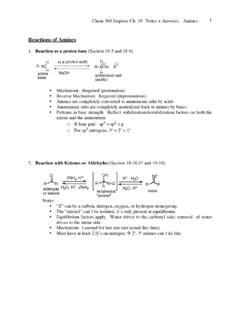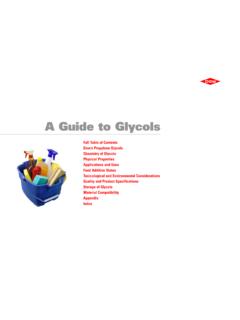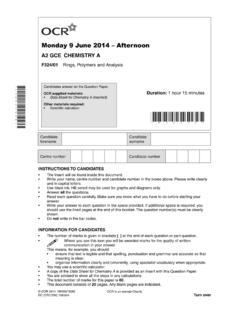Transcription of INTRODUCTION 1.1 General Introduction of Schiff bases
1 1 INTRODUCTION This project has been aimed at the synthesis of some novel heterocyclic compounds like Schiff bases and their cyclisation to produce (Azetidinones) Beta-lactam derivatives of biological significance. General INTRODUCTION of Schiff bases A Schiff base is a nitrogen analog of an aldehyde or ketone in which the C=O group is replaced by C=N-R group. It is usually formed by condensation of an aldehyde or ketone with a primary amine according to the following scheme: Where R, may be an alkyl or an aryl group. Schiff bases that contain aryl substituents are substantially more stable and more readily synthesized, while those which contain alkyl substituents are relatively unstable. Schiff bases of aliphatic aldehydes are relatively unstable and readily polymerizable1,2 while those of aromatic aldehydes having effective conjugation are more stable3-6.
2 The formation of a Schiff base from an aldehydes or ketones is a reversible reaction and generally takes place under acid or base catalysis, or upon heating. 2 The formation is generally driven to the completion by separation of the product or removal of water, or both. Many Schiff bases can be hydrolyzed back to their aldehydes or ketones and amines by aqueous acid or base. The mechanism of Schiff base formation is another variation on the theme of neucleophilic addition to the carbonyl group. In this case, the neucleophile is the amine. In the first part of the mechanism, the amine reacts with the aldehyde or ketone to give an unstable addition compound called carbinolamine loses water by either acid or base catalyzed pathways.
3 Since the carbinolamine is an alcohol, it undergoes acid catalyzed dehydration. Typically the dehydration of the carbinolamine is the rate-determining step of Schiff base formation and that is why the reaction is catalyzed by acids. Yet the acid concentration cannot be too high because amines are basic compounds. If the amine is protonated and becomes non-neucleophilic, equilibrium is pulled to the left and carbinolamine formation cannot occur. Therefore, many Schiff bases synthesis are best carried out at mildly acidic pH. The dehydration of carbinolamines is also catalyzed by base. This reaction is somewhat analogous to the E2 elimination of alkyl halides except that it is not a concerted reaction. It proceeds in two steps through an anionic intermediate.
4 3 The Schiff base formation is really a sequence of two types of reactions , addition followed by elimination7. Chemistry and Biological Importance of Schiff bases . Schiff bases have a large number of synthetic uses in organic chemistry. Acylation of Schiff bases8,9 by acid anhydrides, acid chlorides and acyl cyanides is initiated by attack at the nitrogen atom and leads to net addition of the acylating agent to the carbon-nitrogen double bond. reactions of this type have been put to good use in natural product synthesis. Schiff bases appear to be an important intermediate in a number of enzymatic reactions involving interaction of an enzyme with an amino or a carbonyl group of the substrate. One of the most important types of catalytic mechanism is the biochemical process which involves the condensation of a primary amine in an enzyme usually that of a lysine residue, with a carbonyl group of the substrate to form an imine, or Schiff base.
5 Stereochemical investigation carried out with the aid of molecular model showed that Schiff base formed between methylglyoxal and the amino group of the lysine side chains of proteins can bent back in such a way towards the N atom of peptide groups that a charge transfer can occur between these groups and oxygen atoms of the Schiff bases . In this respect pyridoxal Schiff bases derived from pyridoxal and amino acids have been prepared and studied from the biological point 4 of view. Transition metal complexes of such ligands are important enzyme models. The rapid development of these ligands resulted in an enhance research activity in the field of coordination chemistry leading to very interesting conclusions. The carbon-nitrogen double bond of Schiff bases like the carbon-oxygen double bond is readily reduced by complex metal hydrides8,9.
6 Reduction of this type is probably the most efficient and convenient method for the conversion of C=N into amino compounds. Thus lithium aluminium hydride in THF at room temperature (or in difficult cases at elevated temperature) smoothly reduces Schiff bases in high yield (> 90 %) to secondary amines. Sodium borohydride is an equally effective reducing agent and is preferred to lithium aluminium hydride because of its inertness to a wider range of solvent media and because of its greater specificity in that other substituents such as nitro or chloro reducible by lithium aluminium hydride are unaffected by sodium borohydride. An even more effective reagent of this type is sodium cyanoborohydride (NaBH3CN). Also the base catalyzed condensation of acetyl chlorides (bearing an electron withdrawing group and at least one hydrogen atom at the -position) with N-arylaldimines occurs by initial acylation at the nitrogen atom and leads to -lactams of interest in penicillin chemistry [Scheme 1; (1) + (2) (4)]10.
7 Iminium salt11 (R2C=N+R2) at the other extremes are very rapidly hydrolyzed by water and have to be prepared under rigorously anhydrous conditions. The facility of iminium salt hydrolysis has been put to use in a synthesis of secondary amines from primary amines which involves conversion into the aldimine (R1CH=NR2) and then by alkylation in to the iminium salt [R1CH=N+R2 (R3) X-] followed by hydrolysis 5 to give the secondary amines (R2 NHR3). Because of the involvement of Schiff base hydrolysis in a number of enzyme mediated processes, the detailed mechanism of hydrolytic cleavage of carbon-nitrogen double bonds has been the subject of close scrutiny both under in vivo and under in vitro conditions12. Imines hydrolysis is also a key step in the Sommelet13, Stephen14, Sonn-MulIer15 and Gattermann16 aldehyde synthesis.
8 Alkoxides add in the expected fashion to Schiff bases , giving the corresponding -alkoxy amino compounds9. Addition of this type provides the key step in an elegant 'one pot' stereo specific synthesis of penicillin intermediates which can be further elaborated to new cephalosporin derivatives [Scheme 2; (5) (8)]17. This involves the N-chlorination-dehydrochlorination of readily accessible penicillin amides (5) using t-butyl hypochloride in methanolic borate at 0 C to give acylimines (7), which adds methanol from the less hindered -face to give the adduct (8) with the desired stereochemistry. Hydrogen sulphide reacts readily with N-substituted ketimines at low temperature (-40 to 0 C) to give initial adducts which rapidly react further to afford gemdithiols.
9 N-arylaldimines readily add thiols in the form of their metal salts to give the expected 1,2-adducts which tend to disproportionate with net reduction of the imines to the corresponding amine and concomitant formation of the disulphide8,9. reactions of Schiff bases with primary amines results in adducts which tend to decompose to a new imine and primary amine8,18, the overall process corresponding to imine exchange. The rate of imine exchange increases with increase in the basicity of the primary amine effecting displacement. Sodamide18 reacts with aldimines with 6 formal replacement of the imidyl hydrogen to give amidines [Scheme 3; (9) (10)]. Iminium salts also readily add primary, secondary and tertiary amines with the formation of aminals (gem-diamino compounds) or their quaternary salts19.
10 Schiff bases react in General with ethereal solutions of chloramines in a few hours at room temperature to give moderate to high yields (40-70%) of diaziridines [Scheme 4; (11) (13)]20. This formal cycloaddition reaction has wide scope and is applicable, using chloramine itself (or the comparable reagent hydroxalamine-o-sulphonic acid), as well as N-substituted chloramines to a variety of Schiff bases derived from aldehydes and acyclic and cyclic ketones. In many cases the Schiff base can be converted in situ into the diaziridine (yield 50-80%) by reacting the corresponding carbonyl compound with ammonia or primary or secondary amines in the presence of hydroxalamine-o-sulphonic acid or an N-substituted hydroxalamine-o-sulphonic acid.
